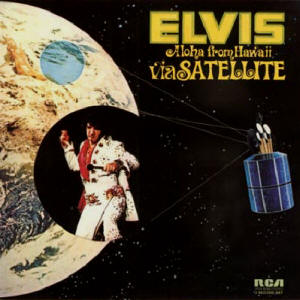
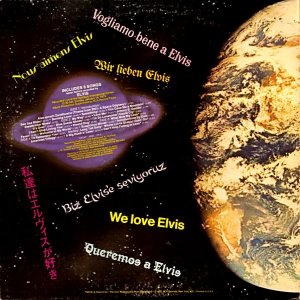

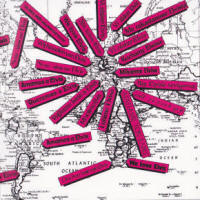
After having promoted the album on the
sleeves of Elvis' two previous long players, RCA
Victor finally released "Aloha From Hawaii Via
Satellite" on February 2, 1973. On the 24th of
the month the double album entered the "Top LPs
Chart", stayed for 52 weeks and peaked at number
1. On March 3rd Billboard also started to list
"Aloha From Hawaii Via Satellite" on the "Hot
Country LPs Chart". Here it had a run of 31
weeks and also became a number 1 hit. By the end
of February 1973 the record set had sold 500,000
times and was certified Gold. Later the RIAA
updated the status to Platinum (1988) Tripple
Platinum (1999) and Quintuple Platinum (2002).
Outside the US "Aloha From Hawaii Via Satellite"
was also very successful, in the Asian area
alone it was retailed more than 3.5 million
times. Worldwide the double album sold ten
million units, which translates to 1.5 billion
paid streams of the complete album. Without
doubt "Aloha" was a commercial triumph.
In 2016 the complete Presley catalogue was
restored and remastered by Vic Anesini for a
boxed set of 60 compact discs called "The Album
Collection". Sony Music Entertainment provides
the streaming platforms with the same versions
of the individual albums (some of them offering
bonus tracks), albeit in 24 bit/90 khz flac.
That means, if the platform of your choice
supports high resolution audio, you can enjoy
the tracks in the same quality Sony used to scan
and master them. On Spotify, which has a market
share of approximately 30% and is the only
platform that publishes streaming figures,
"Aloha From Hawaii Via Satellite" accumulates
1.3 billion streams. Nearly half of them can be
allocated to the deluxe edition, which was
released in 2023 to celebrate the 50th
anniversary of the show. This version was newly
mixed and mastered and also features the
rehearsal concert as well as the bonus tracks,
that Elvis recorded after the main show.
The cover art was designed to fit the hoax of
a global broadcast. A satellite is shown beaming
the king all over the world, on the inside of
the sleeve arrows are pointing at different
regions and reading "We love Elvis" in the
accordant languages. In fact many arrows pointed
at places the special was never shown and "We
love Elvis" was written in languages nobody in
the area the show was actually seen in spoke. On
the first edition the records themselves were
housed in a cardboard sleeve, that showed a
concert photo of Elvis, an advertising for the
album "Elvis As Recorded At Madison Square
Garden" and a strange photomontage of a concert
picture, Hawaiian ladies and an exotic backdrop.
The album cover had a hole, so the photo on the
sleeve for the records appeard at the right
place. In later editions this extravagant
packaging was dropped in favor of a normal album
cover and the usual paper sleeves for the vinyl.
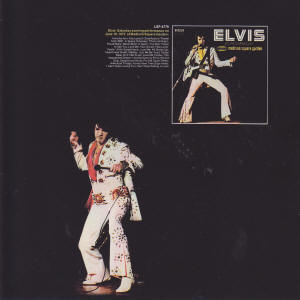
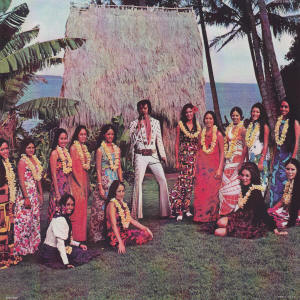
Even though the original album is available
on the streaming platforms in Hi-Res,
the best way to enjoy "Aloha From Hawaii Via
Satellite" is the 50th anniversary edition, as
released in 2023. For this project the original
tapes were scanned again with Hi-Res equipment
and everything was newly mixed and mastered.
Additionaly this version also features the
rehearsal concert and the songs, that were taped
after the main performance. A review of this
special edition can be found
HERE.
The album was recorded on January 14, 1973 at
the Honolulu International Center in O'ahu.
"Aloha" was produced by Joan Deary and
engineered by Al Pachucki, Dick Baxter and Rick
Ruggieri. Technically it was a sophisticated
project, because the show was recorded on
Quadrophonic Sound. This was a forerunner of
today's surround technologies and at first
"Aloha From Hawaii Via Satellite" was solely
available in that format. Regular Stereo
versions were sold exclusively to members of the
RCA Record Club. Several years later it became
clear that the Quadrophonic Sound format
couldn't be established on the market and RCA
switched completely to the Stereo edition.
Elvis' band consisted of James Burton (guitar),
John Wilkinson (guitar), Charlie Hodge (guitar &
harmony vocals), Jerry Scheff (bass), Ronnie
Tutt (drums) and Glen D. Hardin (piano). The
harmony vocals were provided by J.D. Sumner &
The Stamps (Ed Enoch, Bill Baize, Donnie Sumner
and Edward Wideman), The Sweet Inspirations
(Myrna Smith, Silvia Shemwell and Estelle Brown)
as well as Kathy Westmoreland. Joe Guercio
conducted his own orchestra, that was beefed up
for the occasion with the string section of the
Honolulu Symphony Orchestra. In total the double
album has a running time of 62:48 minutes.
Also Sprach ZarathustraJust
like "Elvis As Recorded At Madison Square
Garden" the new live set opens with "Einleitung,
Oder Sonnenaufgang" from Richard Strauss' "Also
Sprach Zarathustra". The classical piece soon
leads into a rhythmical "Opening Riff" to which
Elvis enters the stage.
See See RiderWithout a break
the band moves on to "See See Rider", which is
known from the album "On Stage - February 1970"
and the recent movie "Elvis On Tour". Compared
to both versions Elvis lacks drive and his voice
has a tired undertone. The performance is not
bad at all, but something is missing.
Burning Love
Of course the audience wants to hear the king's
recent top 3 hit "Burning Love". Elvis meets the
expectation, but once again his performance is
very tame.
Something
After a short, very nervous welcome of the
audience the king sings the ballad "Something".
Once again it's no musical feat, because Elvis
sounds strangely lackadaisical and his voice has
a nasal subtone at times. RCA Victor had
recorded the song during the "Elvis Summer
Festival 1970" and considered to release it on
"Love Letters From Elvis". Finally the tape went
into the vaults, so to the fans this was a new
song from the king. Of course the ballad itself
was anything but new. The composition by George
Harrison had been a number 1 hit for The Beatles
and was also included on their "Abbey Road"
album.
You Gave Me A Mountain
This song had not been released by Elvis, too.
Nevertheless some fans might have known it from
"Elvis On Tour", which was shown in the cinemas
in November and December 1972. On this album
"You Gave Me A Mountain" is the king's best
performance so far, but it cannot compete with
his effort in the movie. The song was written
and recorded by Marty Robbins, the most
successful release was by Frankie Lane. In the
musical soap opera the narrator suffers a sad
fate. His mother dies at his birth and his
father blames him for the loss of his wife.
Later he has to go innocently to prison and his
wife leaves him, taking their son with her.
Surprisingly Elvis manages to sell this drivel
in a believable and even dramatic way. He
included "You Gave Me A Mountain" in his stage
show in early 1972 and performed it (with
interruptions) until 1977. A version from June
21, 1977 is featured on the album "Elvis In
Concert".
Steamroller Blues
The song
was written by James Tylor, who recorded it in
1970. The first version was by The Masqueraders
in 1968. In contrast to Tylor
Elvis does not emphasize on the funny lyrics,
but turns the song into some kind of Vegas blues
with lots of brass and backup voices.
Unfortunately he sounds somewhat tired for two
thrids of the performance and he doesn't really
get into it before close to the end. To
promote the forthcoming US screening of "Aloha
From Hawaii Via Satellite" RCA Victor released
the track on a single in March 1973. It peaked
at number 17 and sold two million copies. This
one also had not been recorded by Elvis before.
My Way
The same applies to "My Way". Four years earlier
Frank Sinatra had released the song on an album
of the same name and was able to establish
another signature song for him. The original is
called "Comme D' Habitude" and was written by
Claude Francois, Jacques Revaux and Gilles
Thibault. Later Paul Anka added English lyrics.
Elvis performs "My Way" very well. Another
version can be heared on "Elvis In Concert",
released in October 1977.
Love Me
Just like on "Elvis As Recorded At Madison
Square Garden" the king offers a routine
performance. It's a quick nod to the past.
Johnny B. Goode
The Chuck Berry classic had been featured in
1969 on the double album "From Memphis To Vegas
/ From Vegas To Memphis". This version rocks
like hell, but the the recent outing is tame and
uninspired. To make it worse Elvis looses track
and has to mumble a few words. The highlight of
this performance is James Burton's guitar part.
It's Over
The comparably weak oldies are followed by
another power ballad. RCA Victor had taped two
live performances in early 1972 (one in Las
Vegas/Nevada, the other one in
Richmond/Virginia), but both had gone straight
into the vaults. So to the audience this was
another new song by Elvis. He performs the
number by Jimmy Rodgers very well, I guess he
identified with the lyrics because of his own
situation.
Blue Suede ShoesJust like
the previous "Johnny B. Goode" this one also had
been included on "From Memphis To Vegas / From
Vegas To Memphis" in 1969. And once again it is
obvious how much Elvis had lost interest in his
classics and how little energy he was willing to
invest in his performances by now.
I'm So Lonesome I Could Cry
Now the king announces the saddest song he's
ever heard. Without doubt "I'm So Lonesome I
Could Cry" is one of the highlights of this
show. Elvis sings with lots of emotion and one
believes him every single word. By the way, the
Hank Williams classic was another song the
audience didn't know from the king yet. RCA
later released a remix on the album "Welcome To
My World".
I Can't Stop Loving YouThe
king stays on the field of country music and
presents "I Can't Stop Loving You". This one had
already been released on "From Memphis To Vegas
/ From Vegas To Memphis" (1969) and "Elvis As
Recorded At Madison Square Garden" (1972).
Although his recent performance isn't bad at
all, it doesn't match his earlier efforts.
Hound DogThe same applies to
"Hound Dog". For a minute or so Elvis rattles
off the same four lines over and over again and
sounds as agressive as Bing Crosby.
What Now My LoveEven though
Elvis is not in great voice tonight, he does his
best and manages to perform a sold and emotional
version of "What Now My Love". It's a big
arrangement with lots of orchestra, choir and
drama. The original is called "Et Maintent" and
was written by Gilbert Becaud and Pierre
Delanoe. The English lyrics were added by Carl
Sigman, who also wrote the lyrics of "Fool" (the
b-side of the single "Steamroller Blues"). Once
again "What Now My Love" was new to the fans and
had not been included on any Presley record
before.
FeverElvis throws in another
oldie, but this time he performs it well. He
toys with the audience, triggers reactions of
the ladies and obviously has fun.
Welcome To My WorldThe
country ballad is the final song on this album,
the audience had not heard from Elvis before. In
1963 Jim Reeves had scored a number 2 hit on the
"Country & Western Charts", the authors are Ray
Winkler and John Hathcock. Here and there the
king sounds a little insecure, in general he
uses the song to have fun with the audience. In
1977 RCA made "Welcome To Me World" the title of
a compilation album.
Suspicious MindsThe sales
giant of 1969 had also been included on "From
Memphis To Vegas / From Vegas To Memphis" and
"Elvis As Recorded At Madison Square Garden" and
once again the king's current performance lacked
drive. It wasn't bad but the power was missing.
On the tv screen it became even more evident.
Instead of the athletic fireworks he had burned
down in 1970 the audience got to see a person
doing not much more than walking rhythmically
from one side of the stage to the other.
IntroductionsElvis
introduces the musicians and singers and also
announces that the show had generated 75,000 USD
for the Kui Lee Cancer Fund. The nervousness of
the king is very evident here.
I'll Remember YouNow the
audience gets to hear a song from Kui Lee. Elvis
had released it in 1966 on the soundtrack album
of "Spinout", in 1972 he had started to present
the ballad live on stage. The king performs this
sad and tender song very well, it's certainly
one of the highlights of this show.
Long Tall Sally / Whole Lotta Shakin'
Goin' OnUnfortunately one cannot say
that about this medley. I guess one can find
several inhabitants in every retirement home,
who can perform this rock'n'roll medley with
more zest than Elvis does here.
An American TrilogyThe
lowpoint is followed by the highlight of this
show. In the previous year live recordings of
"An American Trilogy" had been released on a
single and on the album "Elvis As Recorded At
Madison Square Garden". Both versions were
great, but this one tops them off. Elvis is
focused, his voice sounds good and the larger
orchestra adds more volume to the sound. It's a
stunning performance by any means.
A Big Hunk O' LoveAfter
several weak presentations of rock'n'roll songs
Elvis finally comes up with a good one. The song
isn't rushed, the arrangement includes a guitar
solo and a piano solo and the king sings well.
He even appears to enjoy what he is doing. If he
had performed "Blue Suede Shoes", "Johnny B.
Goode", "Hound Dog" and the medley in a similar
way, the show had been much better. It's almost
an insult of the audience to show them to be
able to do rock'n'roll songs well, but not to
bother in most cases.
Can't Help Falling In Love
Now the king tells the audience that he had made
"Blue Hawaii" here about ten years ago and
therefore wants to sing the next song especially
for them. Of course this is pure humbug, because
he closes (almost) every concert with "Can't
Help Falling In Love". None of his live
performances come close to the brillant studio
cut, but once again the presentation here is his
weakest so far. Without a break the musicians
move to the "Closing Riff" to which Elvis leaves
the stage.
Verdict
The many ballads reduce the pace of the
show and several songs are performed with
too little effort. Besides that Elvis' voice
sounds tired at times and has a nasal
undertone not heared before. The show is
grandiose by any means, but something is
missing.

(C) RCA Records
![]()





